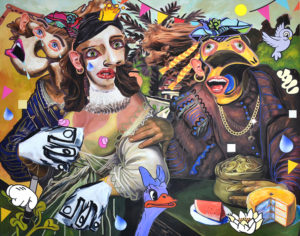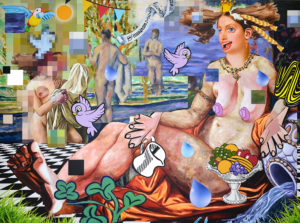
We have become accustomed to the miraculous trajectories birthed out of the age of Instagram: influencers turned designers and memes turned micro-industries among them. Creatively speaking, it’s been a similarly rich launching pad for Insta-conscious artists who have amassed a fan base on the very platform their work references.
One such artist is Allison Zuckerman, a Brooklyn-based painter who rose from gallery girl to Art Basel darling in the span of a few years. “I didn’t have any connections in the art world and I didn’t have that much time to hustle, so I would upload pictures of my work to Instagram and then take those images, put them into Photoshop, and reimagine them again,” she says.
The result was a raucous mashup of digital prints, painted images, and cartoons, blended to simultaneously puzzle and delight the viewer. “[It] plays into this whole phenomenon of social media—it’s really hard to tell what’s real and what’s fabricated at this point,” she says. Her sculptures, which frequently accompany the paintings, take this notion one step further: “They’re a quarter-inch thick, which is the same thickness as a lot of smartphones,” she explains. “To me, it references the flatness of our viewing experience. We’re seeing so much imagery now, whether it’s on your computer or your phone and it’s so packed in, but at the same time shallow.”
Zuckerman’s collages are a wild ride of references to history, emojis, and everything in between. Take, for instance, her painting, The Queen, where the arms from Picasso’s Portrait of a Woman, after Lucas Cranach II live alongside Roy Lichtenstein’s Still Life with Goldfish (itself a reference to Matisse’s The Goldfish)—an example of how the artist flips the script on representation in art by hurling famous pieces of the female form into a world where they might be appreciated for more than their beauty.“

[These works] have been created for men by men, and the women they feature are very anonymous and submissive and idealized,” she says. “I wanted to make work about being a woman and what it feels like to be on view and all of the different counteracting feelings that are part of that.”
The 28-year-old artist compares herself to a disc jockey, sampling moments from male-dominated art history and bringing them into today’s cacophonous, gendered conversation. But while a DJ’s samples are often just beyond reach, there’s nothing subtle about Zuckerman’s riffs. “I feel like I’m inviting those male artists to my party but roasting them at the same time,” she says. To that end, she only appropriates male artists, who she feels have traditionally held the keys.
If Zuckerman’s work is her proverbial power pose, its success is her feminist fruit. This summer, she was crowned Artist in Residence at Miami’s prestigious Rubell Family Collection, which resulted in a summerlong solo show. This October, she’ll mount another at the Akron Art Museum, where the work is sure to be as imposing as it is revelatory. “I want the paintings to be larger than life, because I wanted the female figures to be over-whelming, unavoidable, and intimating.”
